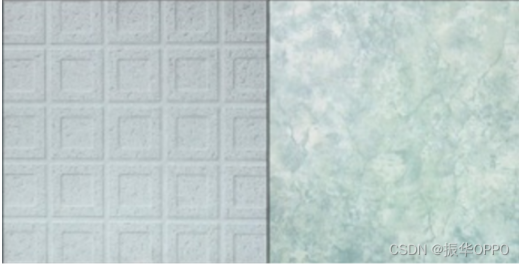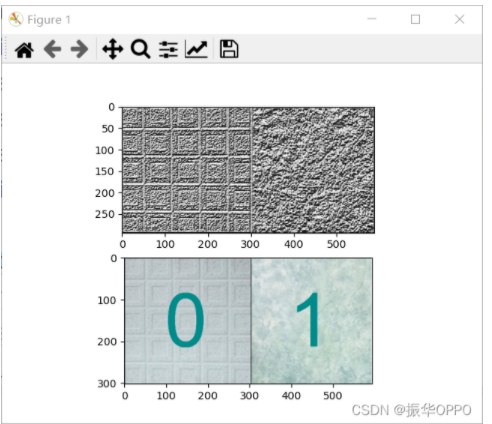1️⃣作业要求
将下图左右两种不同类型的纹理区域分开,方法输出结果是一幅与该图像等大小的二值图像,左边为0,右边为1,或者相反,灰色边框线在设计的方法中不作考虑,自行去除。
2️⃣实现源码
import matplotlib.image as mpimg import matplotlib.pyplot as plt import numpy as np from cv2 import cv2 from sklearn.multiclass import OneVsRestClassifier from sklearn.svm import SVR from skimage import feature as skft from PIL import Image,ImageDraw,ImageFont class Texture(): #n_point选取中心像素周围的像素点的个数 #radius选取的区域的半径 def __init__(self): self.radius = 1 self.n_point = self.radius * 8 #加载灰度图片 def loadPicture(self): train_index = 0 test_index = 0 train_data = np.zeros((10, 171, 171)) test_data = np.zeros((8, 171, 171)) train_label = np.zeros(10) test_label = np.zeros(8) for i in np.arange(2): image = mpimg.imread('dataset1/'+str(i)+'.tiff') data = np.zeros((513, 513)) data[0:image.shape[0], 0:image.shape[1]] = image index = 0 #图片分成9块,5块训练4块预测 for row in np.arange(3): for col in np.arange(3): if index < 5: train_data[train_index, :, :] = data[171*row:171*(row+1),171*col:171*(col+1)] train_label[train_index] = i train_index += 1 else: test_data[test_index, :, :] = data[171*row:171*(row+1),171*col:171*(col+1)] test_label[test_index] = i test_index += 1 index += 1 return train_data, test_data, train_label, test_label #纹理检测 def texture_detect(self): train_data, test_data, train_label, test_label = self.loadPicture() n_point = self.n_point radius = self.radius train_hist = np.zeros((10, 256)) test_hist = np.zeros((8, 256)) #LBP特征提取 for i in np.arange(10): # 使用LBP方法提取图像的纹理特征. lbp=skft.local_binary_pattern(train_data[i], n_point, radius, 'default') # 统计图像的直方图 max_bins = int(lbp.max() + 1) # hist size:256 train_hist[i], _ = np.histogram(lbp, normed=True, bins=max_bins, range=(0, max_bins)) for i in np.arange(8): lbp = skft.local_binary_pattern(test_data[i], n_point, radius, 'default') max_bins = int(lbp.max() + 1) # hist size:256 test_hist[i], _ = np.histogram(lbp, normed=True, bins=max_bins, range=(0, max_bins)) return train_hist, test_hist #训练分类器 SVM支持向量机分类 def classifer(self): train_data, test_data, train_label, test_label = self.loadPicture() train_hist, test_hist = self.texture_detect() #构建SVM支持向量机 svr_rbf = SVR(kernel='rbf', C=1e3, gamma=0.1) model= OneVsRestClassifier(svr_rbf, -1) model.fit(train_hist, train_label) image=cv2.imread('dataset1/image.png',cv2.IMREAD_GRAYSCALE) image=cv2.resize(image,(588,294)) img_ku=skft.local_binary_pattern(image,8,1,'default') thresh=cv2.adaptiveThreshold(image,255,cv2.ADAPTIVE_THRESH_GAUSSIAN_C,cv2.THRESH_BINARY,11,2) #对图像进行识别分类 img_data=np.zeros((1,98,98)) data=np.zeros((294,588)) data[0:image.shape[0],0:image.shape[1]]=image img = Image.open('texture.png') draw = ImageDraw.Draw(img) # 设置字体和大小 myfont = ImageFont.truetype('C:/windows/fonts/Arial.ttf', size=180) # 设置字体颜色 fillcolor = "#008B8B" # 读取图片的size,也就是宽度和高度 width, height = img.size #通过行列将图像分为九块 for row in np.arange(3): for col in np.arange(6): img_data[0,:,:]=data[98*row:98*(row+1),98*col:98*(col+1)] lbp= skft.local_binary_pattern(img_data[0], 8, 1, 'default') max_bins=int(lbp.max()+1) img_hist, _ = np.histogram(lbp, normed=True, bins=max_bins, range=(0, max_bins)) predict=model.predict(img_hist.reshape(1,-1)) if(predict==0): draw.text((width/6, height/6), '0', font=myfont, fill=fillcolor) data[98*row:98*(row+1),98*col:98*(col+1)]=0 else: draw.text((2*width /3, height/6), '1', font=myfont, fill=fillcolor) data[98*row:98*(row+1),98*col:98*(col+1)]=255 plt.subplot(211) plt.imshow(img_ku,'gray') #plt.subplot(312) #plt.imshow(thresh,'gray') plt.subplot(212) plt.imshow(img) plt.show() if __name__ == '__main__': test = Texture() # 计算分类准确度部分 accuracy = test.classifer() #print('Final Accuracy = '+str(accuracy)+'%')
3️⃣实验结果
上面一张图是结果LBP算子特征提取后的图片,下面一张图使用SVM进行纹理分类后得到的结果,与预测的左上图纹理相同标为0,与右上图相同标为1。

